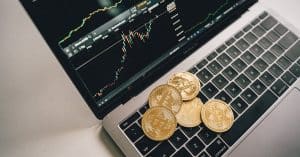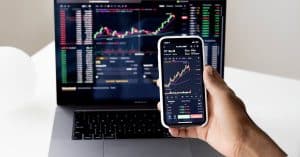Key Takeaways
- Understand VWAP Fundamentals: VWAP combines price and volume data to provide an accurate average trading price.
- Enhanced Trading Decisions: Utilize VWAP to identify market trends and determine optimal entry and exit points.
- Performance Benchmarking: Compare your trade executions against VWAP to evaluate and improve trading performance.
- Strategic Trade Execution: Align trades with VWAP to minimize slippage and reduce market impact.
- Application in Various Strategies: Implement VWAP in day trading and institutional trading to enhance strategy effectiveness.
- Be Aware of Limitations: Recognize that market volatility and liquidity can affect VWAP accuracy and reliability.
Understanding VWAP can significantly enhance your trading strategy. VWAP, or Volume Weighted Average Price, serves as a crucial indicator that combines price and volume data to provide a more accurate reflection of a security’s trading activity.
When you incorporate VWAP into your analysis, you gain insights into market trends and identify potential entry and exit points. It helps you evaluate the performance of your trades against the average market price, ensuring that your decisions are data-driven and informed.
By mastering VWAP, you’ll be better equipped to navigate the complexities of the market and make more strategic trading choices.
Understanding VWAP
Volume Weighted Average Price (VWAP) integrates both price and volume data to calculate the average price at which a security has traded throughout the trading day. You can use VWAP to assess the trading activity by weighting each transaction by its volume.
Calculating VWAP
To compute VWAP, follow these steps:
- Calculate the Typical Price for each trading period:
[
\text{Typical Price} = \frac{\text{High} + \text{Low} + \text{Close}}{3}
]
- Multiply the Typical Price by the Period’s Volume:
[
\text{Typical Price} \times \text{Volume}
]
- Sum the Results from step 2 up to the current period.
- Divide by the Cumulative Volume up to the current period:
[
\text{VWAP} = \frac{\sum (\text{Typical Price} \times \text{Volume})}{\sum \text{Volume}}
]
Importance of VWAP
VWAP serves as a benchmark for traders to evaluate their trading performance against the average market price. You can use VWAP to:
- Identify Market Trends: Prices above VWAP indicate an uptrend, while prices below suggest a downtrend.
- Determine Entry and Exit Points: Traders enter long positions when the price crosses above VWAP and short positions when it crosses below.
- Enhance Trade Execution: VWAP helps in executing large orders with minimal market impact by aligning trades with the average price.
Benefits of Using VWAP
- Enhanced Decision Making: Provides a clear view of market direction by combining price and volume.
- Performance Benchmarking: Allows comparison of trade prices against the VWAP to measure execution quality.
- Strategic Planning: Assists in setting realistic price targets based on aggregated trading data.
VWAP in Trading Strategies
Incorporating VWAP into your trading strategy can lead to more informed and strategic decisions. For instance, aligning your trades with VWAP can help in minimizing slippage and optimizing trade entry and exit points.
Calculating VWAP
Calculating VWAP involves a systematic approach to analyze price and volume data accurately. Understanding the calculation process enhances your ability to apply VWAP effectively in trading strategies.
Formula Breakdown
- Determine the Typical Price: Calculate the average of the high, low, and closing prices for each period.
- Multiply by Volume: Multiply the Typical Price by the period’s traded volume.
- Cumulative Sum: Add the results of all periods up to the current one.
- Divide by Cumulative Volume: Divide the cumulative sum by the total volume traded up to that point.
The formula can be summarized as:
[
\text{VWAP} = \frac{\sum_{i=1}^{n} (\text{Typical Price}_i \times \text{Volume}i)}{\sum{i=1}^{n} \text{Volume}_i}
Required Data
- High Price: The highest price of the security during the period.
- Low Price: The lowest price of the security during the period.
- Closing Price: The final price at the end of the trading period.
- Volume: The total number of shares or contracts traded during the period.
Benefits Of VWAP
VWAP offers multiple advantages that enhance trading strategies and execution. Utilizing VWAP can lead to more informed decisions and optimized trade performance.
Enhanced Decision Making
VWAP provides a clear benchmark by averaging price and volume data. Traders use this benchmark to:
- Identify Trends: Recognize upward or downward market movements.
- Determine Entry Points: Enter trades when prices break above VWAP.
- Set Exit Points: Exit trades when prices fall below VWAP.
By referencing VWAP, you evaluate your trades against the market’s average, ensuring decisions align with prevailing trends.
Improved Trade Execution
Incorporating VWAP into your trading strategy enhances execution quality. Key improvements include:
- Minimized Slippage: Execute trades closer to the market’s average price.
- Optimized Order Placement: Align orders with high-volume periods.
- Reduced Market Impact: Spread orders to avoid disrupting the market price.
Using VWAP as a guide ensures your trades are executed efficiently, maintaining alignment with market dynamics.
Challenges And Limitations
While VWAP offers valuable insights, several challenges and limitations can affect its effectiveness.
Market Conditions Impact
VWAP’s reliability depends on market volatility and liquidity. In highly volatile markets, rapid price changes can distort VWAP calculations, reducing its accuracy as a benchmark. During low liquidity periods, limited trading volume makes VWAP less effective in reflecting true market trends. For instance, in a bull flag pattern, VWAP may not accurately indicate entry or exit points due to insufficient trading activity.
Implementation Issues
Implementing VWAP requires precise data and robust infrastructure. Accurate VWAP calculation depends on real-time access to high, low, and closing prices, along with traded volume. Integrating VWAP into trading platforms can be technically challenging, especially for high-frequency trading where latency must be minimized. Additionally, ensuring data integrity and consistent updates is critical to prevent discrepancies that could impact trading decisions.
VWAP Trading Strategies
VWAP supports various trading strategies tailored to different trading styles. Utilizing VWAP enhances your decision-making and trade execution.
Day Trading
Day traders use VWAP to gauge intraday price trends. Comparing current prices to VWAP helps identify optimal entry and exit points. When prices exceed VWAP, it signals strong buying momentum, presenting potential buy opportunities. If prices fall below VWAP, it indicates selling pressure, suggesting possible sell actions. Combining VWAP with indicators like moving averages refines trade timing and increases precision.
Institutional Trading
Institutions rely on VWAP to execute large orders efficiently. Aligning trades with VWAP minimizes market impact and achieves favorable average prices. Institutions benchmark trade performance against VWAP to ensure executions match market conditions. Additionally, VWAP algorithms split large orders into smaller trades throughout the day, maintaining alignment with overall volume patterns.
Conclusion
Integrating VWAP into your trading arsenal can elevate your strategy and decision-making process. By leveraging the insights VWAP offers, you align your trades with market dynamics effectively. Embracing VWAP allows you to navigate trading complexities with greater confidence and precision. As you refine your approach, VWAP stands as a valuable tool to enhance your trading performance and achieve your financial goals.
Frequently Asked Questions
What is VWAP and why is it important in trading?
VWAP, or Volume Weighted Average Price, combines price and volume data to provide a comprehensive view of a security’s trading activity. It serves as a crucial benchmark for traders, helping them identify market trends and determine optimal entry and exit points. By comparing trade performance against the VWAP, traders can make more informed and strategic decisions, enhancing their overall trading effectiveness.
How is VWAP calculated?
VWAP is calculated by first determining the Typical Price, which is the average of the high, low, and closing prices. This value is then multiplied by the period’s traded volume. The cumulative sum of these results is divided by the cumulative volume for the period. This process provides a weighted average that reflects both price movements and trading volume.
What are the benefits of using VWAP in trading strategies?
Using VWAP offers several benefits, including improved decision-making by providing a clear market benchmark. It helps traders identify trends, determine optimal entry and exit points, and benchmark their performance against the average market price. Additionally, VWAP aids in minimizing slippage and optimizing trade execution, leading to more efficient and strategic trading practices.
What are the limitations of VWAP?
VWAP can be less reliable in highly volatile or low liquidity markets, where rapid price changes or limited trading volume can distort its accuracy. Additionally, implementing VWAP requires precise data and robust infrastructure, which can be challenging for high-frequency trading environments. Ensuring data integrity and minimizing latency are crucial to maintaining VWAP’s effectiveness as a trading benchmark.
How can day traders use VWAP in their trading?
Day traders use VWAP to gauge intraday price trends and identify optimal entry and exit points. When prices are above VWAP, it indicates strong buying momentum, while prices below VWAP suggest selling pressure. By monitoring price movements relative to VWAP, day traders can make informed decisions that align with current market trends and improve their trading performance.
How do institutions utilize VWAP for order execution?
Institutions use VWAP to execute large orders efficiently while minimizing market impact. They benchmark trade performance against VWAP and often employ algorithms to split large orders into smaller trades throughout the day. This strategy ensures that their trading aligns with overall volume patterns, achieving favorable average prices and reducing the likelihood of significant price movements against their positions.
Can market conditions affect VWAP’s reliability?
Yes, market conditions such as high volatility and low liquidity can impact VWAP’s reliability. In volatile markets, rapid price changes may hinder accurate VWAP calculations, while low liquidity can limit its ability to reflect true market trends. These conditions can reduce VWAP’s effectiveness as a benchmark, making it essential for traders to consider the prevailing market environment when relying on VWAP for trading decisions.
What data is needed to calculate VWAP?
Calculating VWAP requires the high, low, and closing prices of the security for each trading period, as well as the volume traded during those periods. Accurate and timely access to this data is essential for computing VWAP correctly, ensuring that traders have a reliable benchmark for evaluating their trading performance and making informed decisions.
How does VWAP help minimize slippage?
VWAP helps minimize slippage by providing a benchmark that traders can use to align their order placements with the average market price. By executing trades near the VWAP, traders reduce the likelihood of unfavorable price movements between order submission and execution. This leads to more efficient trade execution and helps maintain the intended trading strategy.
What are some common VWAP trading strategies?
Common VWAP trading strategies include using VWAP as a trend indicator, where prices above VWAP suggest a bullish trend and below indicate a bearish trend. Traders also use VWAP for mean reversion strategies, buying when prices dip below VWAP and selling when they rise above it. Additionally, VWAP is often used in algorithmic trading to ensure large orders are executed in line with overall market volume, reducing market impact and achieving better average prices.






